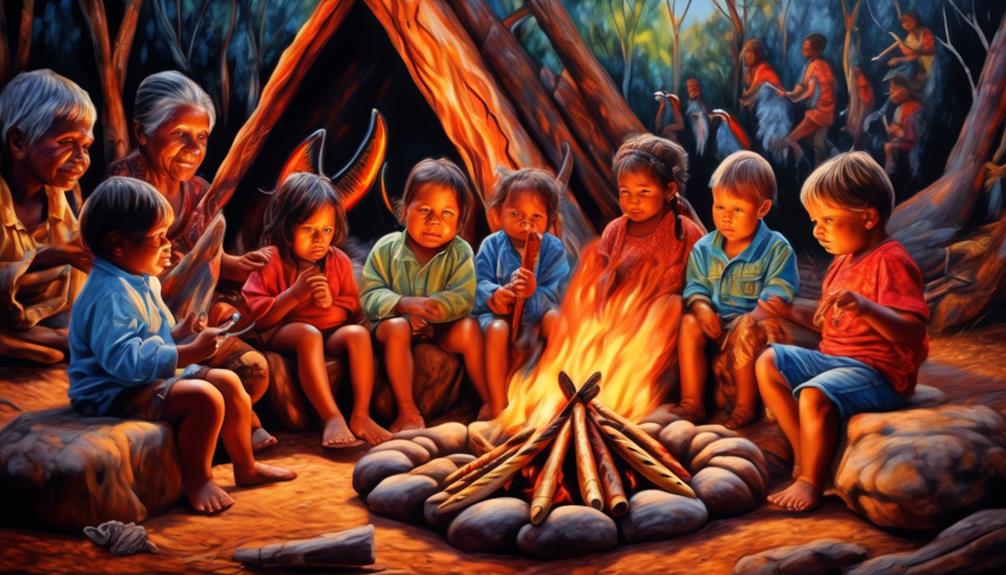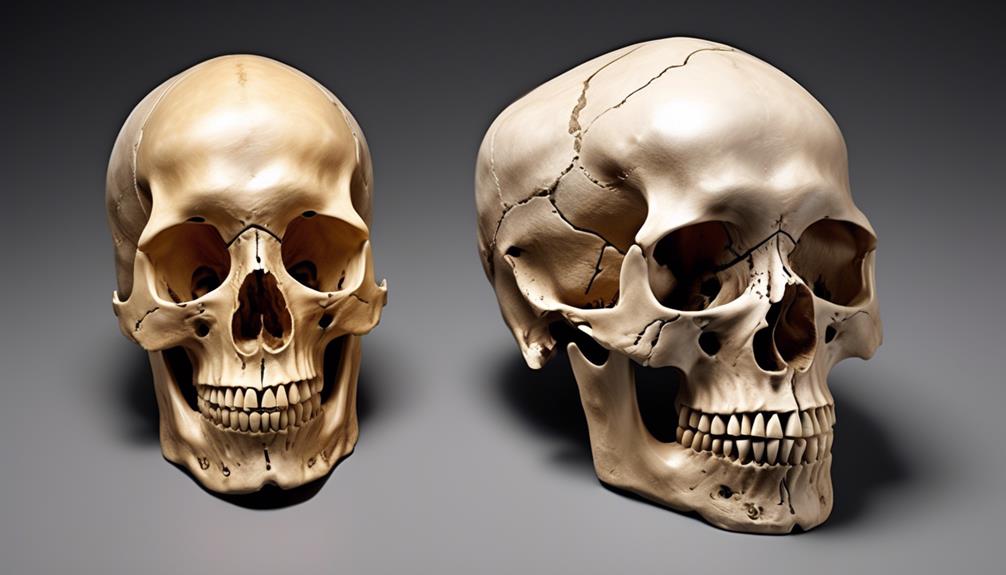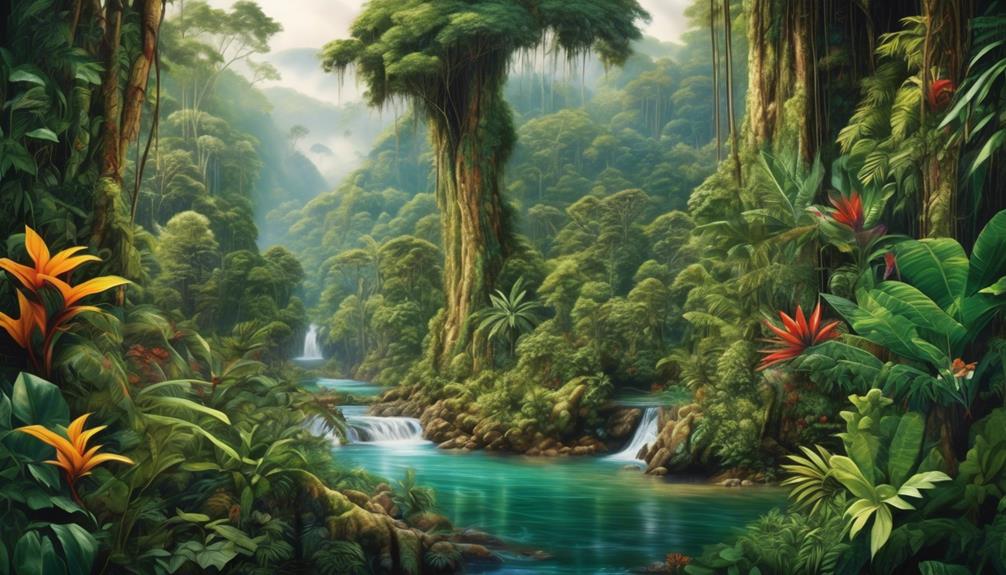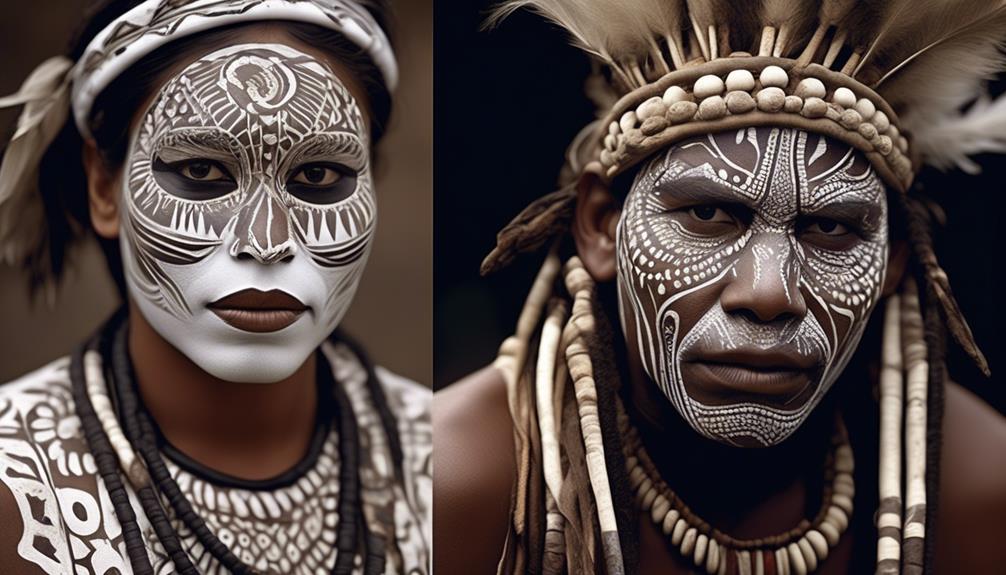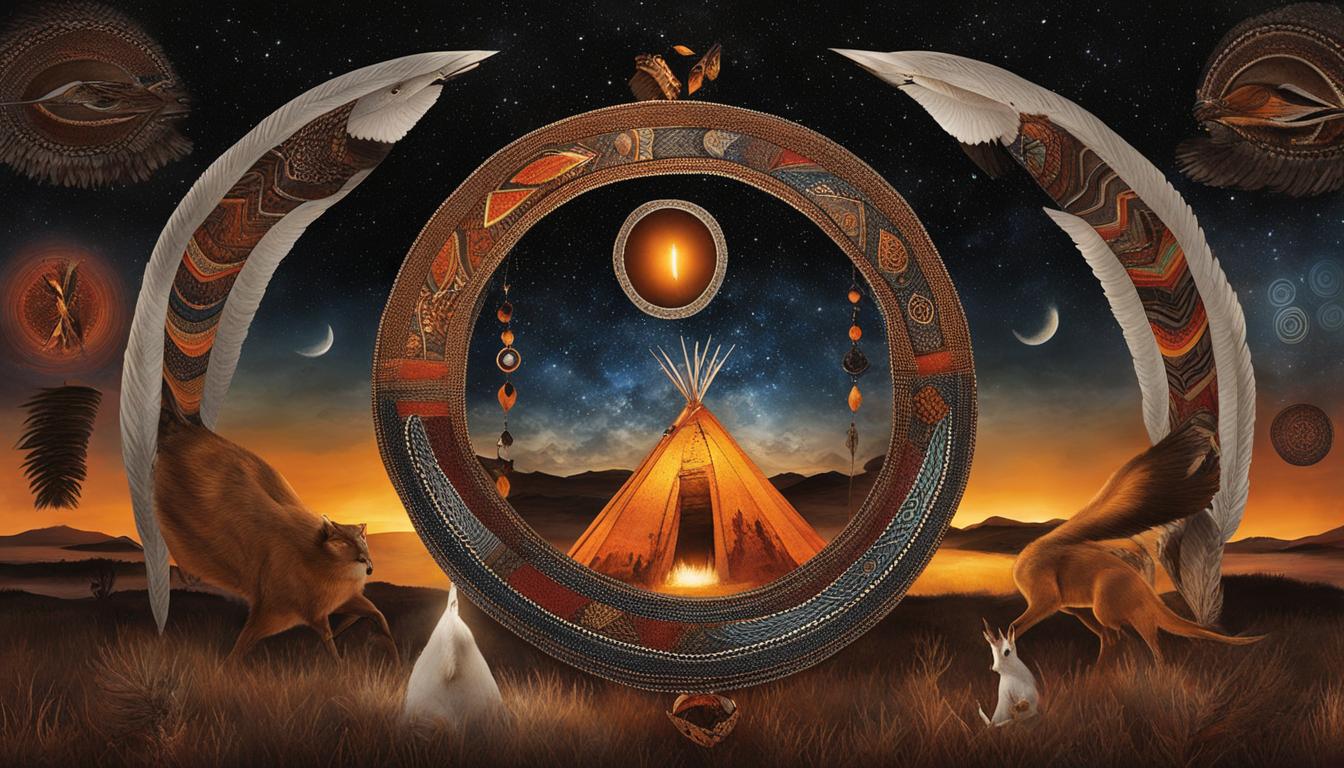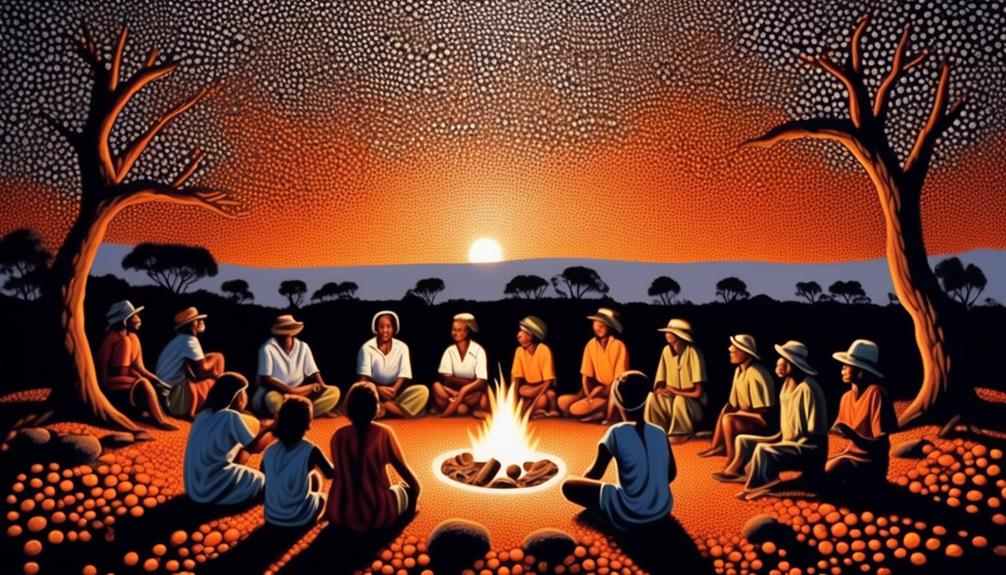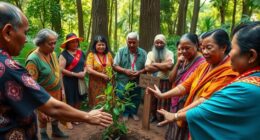Imagine your child taking part in a traditional Aboriginal storytelling session, with their eyes filled with wonder as they hear captivating tales of the Dreamtime.
The rich cultural heritage of Australia's Indigenous peoples offers a myriad of experiences that can enrich your child's early years.
But how can these experiences benefit your toddler's development and understanding of the world around them?
Key Takeaways
- Aboriginal storytelling fosters cultural understanding and imagination
- Traditional Aboriginal art activities introduce symbolism and colors of Aboriginal art
- Music and dance from Aboriginal cultures enhance rhythm, coordination, and physical activity
- Exploring nature and traditional practices promotes understanding, respect, and appreciation for diverse ways of life
Storytelling and Indigenous Legends
Engage your toddler in the rich tradition of Aboriginal storytelling and legends to foster cultural understanding and imagination. Indigenous storytelling is a powerful way to introduce your little one to the vibrant cultures and traditions of Aboriginal peoples. Through these stories, children can learn about the values, beliefs, and history of Indigenous communities. By sharing cultural legends, you can ignite a sense of wonder and curiosity in your toddler, allowing them to explore different perspectives and ways of life.
Immersing your toddler in Indigenous storytelling provides an opportunity to instill respect for diverse cultures from a young age. As you delve into these tales, encourage your child to ask questions and express their thoughts. By doing so, you can create an inclusive environment where your toddler feels comfortable exploring and learning about Indigenous traditions.
Cultural legends offer a window into the rich tapestry of Indigenous heritage, nurturing empathy and understanding in toddlers. Through these narratives, children can develop a deep appreciation for the wisdom and customs of Aboriginal communities. Embrace the magic of Indigenous storytelling as a way to spark your toddler's imagination and cultivate a lifelong respect for diverse cultures.
Traditional Aboriginal Art Activities
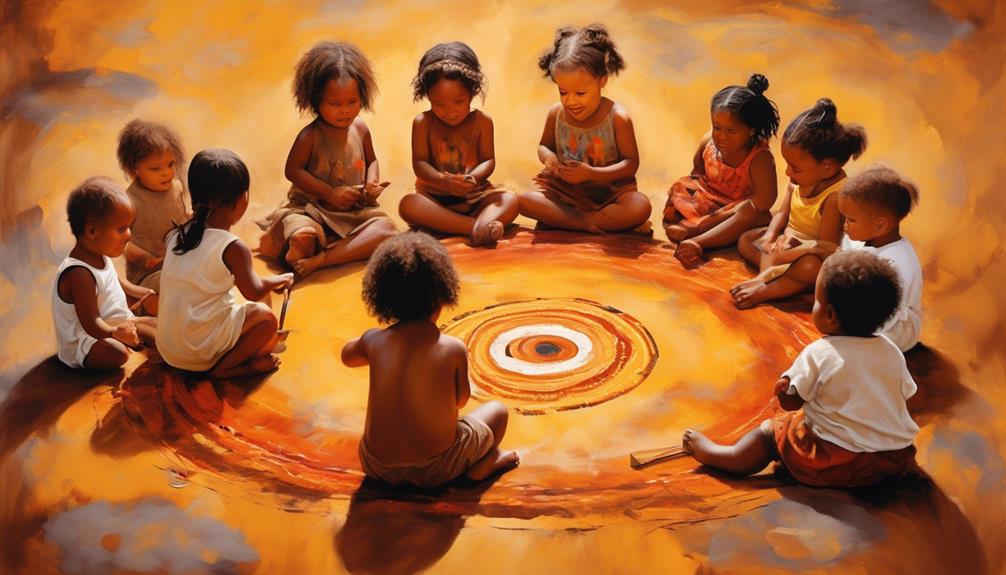
Immerse your toddler in the vibrant world of Traditional Aboriginal Art Activities to inspire creativity and cultural appreciation. Engaging in art and crafts inspired by Aboriginal culture provides an opportunity for your little one to learn about the rich traditions and stories of Indigenous peoples.
- Dot Painting: Introduce your toddler to the mesmerizing technique of dot painting, a hallmark of Aboriginal art. Using cotton swabs or round sponge applicators, your child can create their own dot paintings, learning about the significance of different symbols and colors used in this traditional art form.
- Rock Art: Take your toddler on a nature walk to collect smooth rocks, which can then be transformed into beautiful pieces of rock art. Allow them to use non-toxic paint to depict traditional Aboriginal symbols or their own interpretations of nature, connecting them to the land and its significance in Aboriginal culture.
- Dream Catchers: While dream catchers aren't traditionally Aboriginal, they can be adapted to incorporate Aboriginal symbols and colors, offering a chance for your toddler to engage in cultural learning while creating a beautiful and meaningful piece of art.
Engaging in these activities won't only foster your toddler's creativity but also deepen their understanding and appreciation of Aboriginal culture and art.
Music and Dance From Aboriginal Cultures
Discover the vibrant rhythms and expressive movements of music and dance from Aboriginal cultures, inviting your toddler to join in and experience the rich traditions firsthand. Indigenous drumming and cultural dance are integral parts of Aboriginal traditions, offering a window into the heart of their communities. Through traditional music, storytelling techniques, and art, toddlers can engage with Aboriginal legends and learn about nature exploration, festival celebrations, and holiday traditions. These experiences provide a unique opportunity for toddlers to develop an understanding and appreciation for traditional practices while fostering a sense of inclusivity and respect for diverse cultures. By incorporating these elements into your toddler's activities, you can create an environment that encourages curiosity and a deeper understanding of the world around them.
| Aboriginal Music & Dance | Description | Benefits |
|---|---|---|
| Indigenous Drumming | Heartbeat of the culture | Enhances rhythm & coordination |
| Cultural Dance | Expressive movements | Promotes physical activity |
| Storytelling Techniques | Oral tradition | Encourages language skills |
| Art Techniques | Visual representation | Fosters creativity |
Exploring Nature and Traditional Practices

Embark on a journey of exploration and appreciation for the natural world and traditional practices, inviting your toddler to actively participate in their surroundings and learn from the wisdom of Indigenous cultures. Nature walks provide an opportunity for your toddler to engage with the environment, developing a deep connection with the land and its inhabitants. Indigenous cultural activities offer a window into traditional practices, fostering an understanding and respect for diverse ways of life.
Here are three ways to incorporate nature walks and cultural activities into your toddler's routine:
- Guided Nature Walks: Seek out local Indigenous guides who can lead nature walks, sharing their knowledge of the land, plants, and animals. This not only exposes your toddler to the natural world but also instills a sense of reverence and stewardship for the environment.
- Traditional Crafting Workshops: Participate in workshops that teach traditional crafting methods, such as basket weaving or beadwork. These activities aren't only fun for toddlers but also serve as a way to preserve and pass down Indigenous cultural practices.
- Storytelling Sessions: Attend storytelling sessions where Indigenous elders or knowledge keepers share traditional stories and legends. This oral tradition not only entertains but also imparts valuable lessons about respect, kindness, and the interconnectedness of all living things.
Celebrating Aboriginal Festivals and Holidays
Explore the rich tapestry of Aboriginal culture by participating in the vibrant celebrations and traditional observances of Aboriginal festivals and holidays. These events are deeply rooted in the cultural significance and history of Indigenous peoples and offer a wonderful opportunity for toddlers to immerse themselves in Aboriginal traditions. From traditional cuisine to modern celebrations, there is much to discover and enjoy.
| Aboriginal Festival | Cultural Significance | Traditional Cuisine |
|---|---|---|
| NAIDOC Week | Celebrates Aboriginal culture, history, and achievements. | Bush tucker tastings and traditional cooking demonstrations. |
| Sorry Day | Commemorates the mistreatment of Aboriginal people. | Sharing traditional dishes and reflecting on the past. |
| Yabun Festival | Showcases Aboriginal music, dance, and art. | Food stalls offering Indigenous foods and delicacies. |
| Survival Day | Honors the resilience of Aboriginal and Torres Strait Islander peoples. | Barbecues featuring kangaroo, emu, and other native ingredients. |
Participating in these festivals and holidays not only provides a glimpse into the rich heritage of Aboriginal culture but also fosters respect, understanding, and appreciation for Indigenous traditions. It's a beautiful way for toddlers to learn about and celebrate the diversity of Australia's First Nations peoples.
Frequently Asked Questions
Are There Any Specific Guidelines for Parents to Respectfully Engage With Aboriginal Storytelling and Legends With Their Toddlers?
When engaging with Aboriginal storytelling and legends with toddlers, it's important to approach it with respect and cultural sensitivity. You can start by researching and learning about the specific cultural traditions and practices.
Then, find age-appropriate resources that accurately represent these stories. Engaging with the material alongside your toddler and fostering open discussions can help instill a sense of respect and understanding for Aboriginal culture.
How Can Toddlers Participate in Traditional Aboriginal Art Activities in a Safe and Age-Appropriate Manner?
To ensure safe art participation, prioritize cultural sensitivity and age-appropriate traditional activities for toddlers.
Engage them in supervised, hands-on experiences like dot painting or creating clay sculptures to foster their understanding of Aboriginal art.
Use non-toxic materials and provide guidance to ensure safety.
Emphasize respect for the cultural significance of the activities.
Encourage exploration and creativity while honoring the traditions of Aboriginal art in a manner suitable for their age.
Are There Any Specific Resources or Recommendations for Introducing Music and Dance From Aboriginal Cultures to Toddlers?
When introducing indigenous music and dance to toddlers, it's important to find age-appropriate resources.
Engage with Aboriginal storytelling through interactive and lively sessions.
Explore traditional art activities that incorporate movement and rhythm.
Encourage toddlers to join in and experience the culture through music and dance.
Utilize resources that are respectful and inclusive, allowing toddlers to immerse themselves in the rich traditions of Aboriginal cultures.
What Are Some Ways for Toddlers to Explore Nature and Traditional Practices in a Culturally Sensitive Manner?
To explore nature and traditional practices in a culturally sensitive way, engage toddlers in outdoor activities like gardening, bird watching, and nature walks.
Incorporate traditional practices through storytelling, crafts, and music.
Encourage parental involvement by inviting them to participate in these activities and share their own cultural experiences.
Emphasize respect for nature and diverse traditions, fostering an inclusive and engaging environment for toddlers to learn and appreciate different cultures.
Are There Any Specific Ways for Toddlers to Participate in and Celebrate Aboriginal Festivals and Holidays?
Looking for toddler-friendly cultural activities? Get ready to celebrate Aboriginal festivals and holidays with inclusive ideas!
Engage in traditional dances or create artwork inspired by indigenous symbols. Did you know that 85% of Aboriginal communities celebrate at least one cultural festival each year?
Embrace the spirit of togetherness through storytelling, music, and nature-based activities. Encourage toddlers to participate in traditional crafts and games to foster a sense of belonging and appreciation for Aboriginal culture.
Conclusion
In conclusion, incorporating Aboriginal experiences into your toddler's learning can provide a rich and diverse cultural education.
By storytelling, creating art, exploring nature, and celebrating festivals, you can help your child develop a deep appreciation for Indigenous cultures.
As the saying goes, 'It takes a village to raise a child,' and by embracing Aboriginal experiences, you're enriching your child's understanding of the world and fostering a sense of inclusivity and respect for all cultures.
